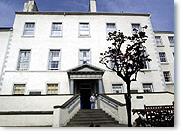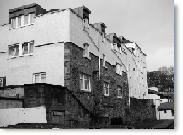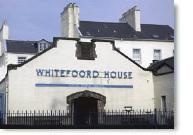It was a famed residence for foreign Ambassadors, who's host were the Lord's Seton, and in particular a favourite with the French Ambassadors, and Manzeville sojourned there in 1583. It's proximity to the Royal Palace gave the family a futher close presence to the Monarch, and was a much coveted property of the Canongate.
Where Whiteford House stands now, in Edgar's map for
1765 there are shown two blocks of buildings (with a
narrow passage between, and a garden 150 feet long)
marked, "Ruins of the Earl of Winton's house," a
stately edifice, which, no doubt, had fallen into a
state of dilapidation from its extreme antiquity and
abandonment after the attainder of George, fourth
Earl of Winton, who was taken prisoner in the fight
at Preston in 1715, -but who, after being sentenced
to death, escaped to Rome, where he died in 1749,
without issue, ac-cording to Sir Robert Douglas ;
and, of course, is the same house that has been
mentioned in history as the Lord Seton's lodging "
in the Canongate " wherein on his arrival from
England, "Henrie Lord Dernlie, eldest son of Matho,
erle of Lennox," resided when, prior to his
marriage, he came to Edinburgh on the 13th of
February, 1565, as stated in the " Diurnal of
Occurrents."
In the same house was lodged, in 1582, accord-ing to
Moyse, Mons. De Menainville, who came as an extra
ambassador from France, with instruc-tions to join
La Motte Fenelon. He landed at Burntisland on the
18th of January, and came to Edinburgh where he had
an audience with James VI. on the 23rd, to the great
alarm of the clergy, -who dreaded this double
attempt to revive French influence in Scottish
affairs. One Mr. James Lawson " pointed out the
French ambassaye" -as the mission of the King of
Babylon, and charac-terised Menainville as the
counterpart of the -blaspheming Rabshakeh.
Upon the 10th February, says Moyse, "La Motte having
received a satisfying answer to his commission, with
a great banquet at Archibald Stewart's lodgings in
Edinburgh took his journey homeward, and called at
Seaton by the way. The said Monsieur Manzeville
remained still here, and lodging -at my Lord
Seaton's house in the Canongate, had daily access to
the king's majesty, to whom he imparted his
negotiations at all times.
"In this house died, of hectic fever, in December,
1638, Jane, Countess of Sutherland, grand-daughter
-of the first Earl of Winton. She "was interred at
the collegiat churche of Setton, without any
funerall ceremoncy, by night."
In front of this once noble mansion, in which Scott
lays some of the scenes of the "Abbot," there sprang
up a kind of humble tavern, built chiefly of lath
and plaster, known as "Jenny Ha's," from Mrs. Hall,
its landlady, famous for her claret. Herein Gay, the
poet, is said to "have boosed ,during his short stay
in Edinburgh; " and to this tavern it was customary
for gentlemen to adjourn after dinner parties, to
indulge in claret from the butt.
On the site of the Seton mansion, and surrounded by
its fine old gardens, was raised the present edifice
known as Whiteford House, the residence of -Sir John
Whiteford, Bart., of that ilk and Balloch-myle, a
locality in Ayrshire, on which the muse of Burns has
conferred celebrity, and whose father is said to
have been the prototype of Sir Arthur Wardour in the
"Antiquary." Sir John was one or the early patrons
of Burns, who had been introduced to him by Dr.
Mackenzie, and the grateful bard never forgot the
kindness he accorded to him. The failure of Douglas,
Heron, & Co., in whose bank he had a fatal interest,
compelled him to dispose of beautiful Ballochmyle,
after which he resided permanently in Whiteford
House, where he died in 1803. To the last he
retained a military bearing, having served in the
army, and been a major in 1762.
Latterly, and for many years, Whiteford House was
best known as the residence of Sir William Macleod
Bannatyne, who was raised to the bench on the death
of Lord Swinton, in 1799, and was long remembered as
a most pleasing example of the old gentleman of
Edinburgh "before its antique mansions and manners
had fallen under the ban of modern fashion."
One of the last survivors of the Mirror Club, in
private life his benevolent and amiable qualities of
head and heart, with his rich stores of literary and
historical anecdote, endeared him to a numerous and
highly distinguished circle of friends.
Robert Chambers speaks of breakfasting with him in Whiteford House so late as 1832, "on which occasion the venerable old gentleman talked as familiarly of the levees of the sous-ministre for Lord Bute in the old villa at the Abbey Hill as I could have talked of the Canning administration, and even recalled, as a fresh picture of his memory, his father drawing on his boots to go to make interest in London on behalf of some men in trouble for the '45, particularly his own brother-in-law, the Clanranald of that day." He died at Whiteford House on the 30th of November, 1833, in the ninety-first year of his age. His mansion was latterly used as a type-foundry.
The Seton's were among the noble families who kept a town house as close as possible to the Royal residence, and their Lodging was frequently visited by international guests such as foreign ambassadors, such as Manzeville who wrote high praise to Scotland's Monarch, and to his King of his princely accommodations at the Seton Lodge. Many of these impressive homes, built just outside the old city walls, also had large formal gardens and fruit orchards, as was the case with the Seton's town-mansion. However, not only for accommodation or political reason's, the Seton Lodging also provided a security function for the Royal Family as all family residences had.
George, 7th Lord Seton was Provost of both Edinburgh and Elgin, and Master of the Royal Household under Queen Mary Stuart and was famed for his enduring support of his Queen, known at Queen of Scots. It was here then, that Henry Stewart, Lord Darnley, stayed the night before he married Mary, Queen of Scots at the Palace of Holyroodhouse in July 1565. According to the Seton family records, the young Queen was also invited to a private reception at the Lodging to celebrate her wedding to the handsome Darnley. But, ironically, it was also a place of refuge for Mary after the brutal murder of her favourite confident, David Rizzio, thanks to her jealous husband. And from here too Lord Seton is recorded as taking command during a famous Edinburgh riot, having armed the guards and successfully quelled the disturbance. Likewise, it is also at the center of the famed clash, or feud, between the Seton and Leslie families in Edinburgh.
An illumination of the house was written in the story by Sir Walter Scott, in "The Abbott": This door, which Roland Graeme instantly approached, opened on a large and well-lighted gallery, at the upper end of which he could hear several voices, and the noise of hasty steps approaching towards the hall or vestibule. A little recalled to sober thought by an appearance of serious danger, he was deliberating whether he should stand fast or retire, when Catherine Seyton re-entered from a side door, running towards him with as much speed as a few minutes since she had fled from him.
“Oh, what mischief brought you hither?” she said; “fly—fly, or you are a dead man,—or stay—they come—flight is impossible—say you came to ask for Lord Seyton.” She sprung from him and disappeared through the door by which she had made her second appearance; and, at the same instant, a pair of large folding-doors at the upper end of the gallery flew open with vehemence, and six or seven young gentlemen, richly dressed, pressed forward into the apartment, having, for the greater part, their swords drawn.
“Who is it,” said one, “dare intrude on us in our own mansion?”. “Cut him to pieces,” said another; “let him pay for this day’s insolence and violence—he is some follower of the Rothes.”. “No, by Saint Mary,” said another; “he is a follower of the arch-fiend and ennobled clown Halbert Glendinning, who takes the style of Avenel—once a church-vassal, now a pillager of the church.”. “It is so,” said a fourth; “I know him by the holly-sprig, which is their cognizance. Secure the door, he must answer for this insolence.”
Two of the gallants, hastily drawing their weapons, passed on to the door by which Roland had entered the hall, and stationed themselves there as if to prevent his escape. The others advanced on Graeme, who had just sense enough to perceive that any attempt at resistance would be alike fruitless and imprudent. At once, and by various voices, none of which sounded amicably, the page was required to say who he was, whence he came, his name, his errand, and who sent him hither. The number of the questions demanded of him at once, afforded a momentary apology for his remaining silent, and ere that brief truce had elapsed, a personage entered the hall, at whose appearance those who had gathered fiercely around Roland, fell back with respect..."My Lord Seyton"... Excerpt from Sir Walter Scott's, "The Abbott".
By the early 18th century, the Lodging was no longer such a desirable residence, having fallen into ruin. George Seton, the fifth Earl of Winton, took part in the Jacobite uprising of 1715, but following his capture at Preston he was found guilty of high treason and condemned to death. Seton miraculously escaped from the Tower of London in 1716 – cutting through the bars of his cell - and later died in Rome, part of Chevalier's Cabinet, in 1749. His family town house, like that of his own Palace of Seton, was raised by the Hanoverian troops during the incitement towards Jacobite supporters in 1715. And while the Earl of Winton managed to escape, his family home fared less well.
Following the forfeiture, the house fell into a
state of disrepair between 1715 and 1744 when it was
sold to the British Linen Company. Later, in
1766, the house was acquired by Sir John Whitefoord
of Ballochmyle. And although little was done
to the former stately residence until 1769, it was
then that Whitefoord hired the noted Architect
Robert Milne to remodel the crumbling ruin using the
existing house, whereupon it was re-named "Whitefoord
House". Whitefoord himself is now best
remembered as an enthusiastic patron of the poet
Robert Burns, once writing these words of
encouragement to the struggling young poet:
"Your character as a man, as well as a poet,
entitles you, I think, to the assistance of every
inhabitant of Ayrshire."
After Sir John died in 1803, Whitefoord became home to the well-known judge, Sir William MacLeod Bannatyne. However, following Bannantyne's death in 1833 at the age of 90, the house that had long been a home to noblemen, was reduced to being used as a factory. The Whitefoord family sold the house in 1850, and it was then converted for use as a type foundry for almost 50 years.
Beginning in 1910, Whitefoord House entered a new and far more stable era. It was bought by Scottish Veterans' Residences (SVR), a charity founded by two former Seaforth Highlanders - Charles Pelham Burn and Chilton Lind Addison Smith - who were appalled at finding Boer War veterans sleeping rough on the streets of Edinburgh. The purchase of the property was funded by a donation in February, 1910, from Mr. and Mrs. W G McLaren who had lost their son in the conflict. An ideal location, it is situated on the north side of Edinburgh's Canongate, and Whitefoord House was the first of the Scottish Veteran's Residences to be purchased by them. The founding of SVR, then, predates the Royal British Legion Scotland which was established by Field Marshal Earl Haig in 1921.
Through the Royal British Legion, in 1926, the first Lady Haig Poppy Factory was established at Whitefoord House, by the wife of Field Marshal Douglas Haig (1861 - 1928). It was established in the Maclagan Room at Whitefoord House, where the residents made poppies here for sale throughout Scotland to raise money to support their fellow ex-servicemen. And now, after two World Wars and conflicts in Korea, the Falklands and the Gulf, Whitefoord House remains a veterans' residence today and is home to more than 80 former servicemen and women.
Marion Anderson, SVR's fundraising and marketing spokesperson, says that while Whitefoord has been extensively renovated to provide veterans with modern facilities many of the original features of the building have been preserved. "I believe that some of the original staircases are still here, and the MacLagan Room, which is used as the residents' cafe and social area, was the original poppy factory," she says. Also remaining in three-storey white-harled building is its old stone Roman-Doric porch.






